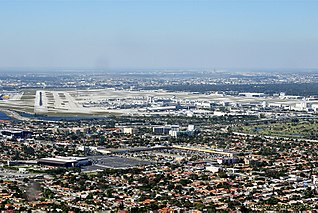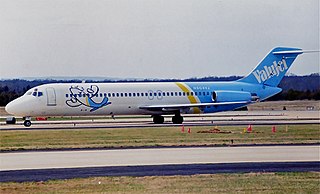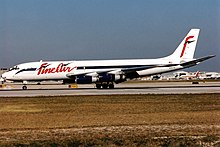Martinair is a Dutch cargo and passenger airline headquartered and based at Amsterdam Airport Schiphol and a subsidiary of Air France–KLM. The airline was founded in 1958 by Martin Schröder. Since 2011, Martinair has operated entirely as a cargo airline with scheduled services to 20 destinations worldwide and additional charter flights. Prior to that date, passenger flights were also operated.
Eastern Air Lines, also colloquially known as Eastern, was a major airline in the United States that operated from 1926 to 1991. Before its dissolution, it was headquartered at Miami International Airport in an unincorporated area of Miami-Dade County, Florida.

Miami International Airport, also known as MIA and historically as Wilcox Field, is the primary airport serving the greater Miami metropolitan area with over 1,000 daily flights to 167 domestic and international destinations, including most countries in Latin America. The airport is in an unincorporated area in Miami-Dade County, 8 miles (13 km) west-northwest of Downtown Miami, in metropolitan Miami, adjacent to the cities of Miami and Miami Springs, and the village of Virginia Gardens. Nearby cities include Hialeah, Doral, and the Census-designated place of Fontainebleau.
Kalitta Air is an American cargo airline headquartered at Willow Run Airport, Ypsilanti Township, Michigan. The company operates international scheduled and cargo charter services. Its call sign "Connie" is from its founder, Connie Kalitta.

Fort Lauderdale–Hollywood International Airport is a major public airport in Broward County, Florida, United States. It is one of three airports serving the Miami metropolitan area. The airport is off Interstate 595, Interstate 95, U.S. Route 1, Florida State Road A1A, and Florida State Road 5 bounded by the cities Fort Lauderdale, Hollywood, and Dania Beach, 3 miles (5 km) southwest of downtown Fort Lauderdale and 21 miles (34 km) north of Miami.
Arrow Air was a passenger and cargo airline based in Building 712 on the grounds of Miami International Airport (MIA) in Miami-Dade County, Florida. At different times over the years, it operated over 90 weekly scheduled cargo flights, had a strong charter business and at one point operated scheduled international and domestic passenger flights. Its main base was Miami International Airport. Arrow Air ceased operations on June 29, 2010, and filed for Chapter 11 bankruptcy protection on July 1, 2010. It was then liquidated.

The McDonnell Douglas MD-80 is a series of five-abreast single-aisle airliners developed by McDonnell Douglas. It was produced by the developer company until August 1997 and then by Boeing Commercial Airplanes. The MD-80 was the second generation of the DC-9 family, originally designated as the DC-9-80 and later stylized as the DC-9 Super 80 . Stretched, enlarged wing and powered by higher bypass Pratt & Whitney JT8D-200 engines, the aircraft program was launched in October 1977. The MD-80 made its first flight on October 18, 1979, and was certified on August 25, 1980. The first airliner was delivered to launch customer Swissair on September 13, 1980, which introduced it into service on October 10, 1980.

ValuJet Airlines Flight 592 was a regularly scheduled flight from Miami to Atlanta. On May 11, 1996, the ValuJet Airlines McDonnell Douglas DC-9 operating the route crashed into the Everglades about 10 minutes after departing Miami as a result of a fire in the cargo compartment possibly caused by mislabeled and improperly stored hazardous cargo. All 110 people on board were killed. The airline already had a poor safety record before the crash, and the accident brought widespread attention to the airline's problems. ValuJet's fleet was grounded for several months after the accident. When operations resumed, the airline was unable to attract as many customers as it had before the accident. It acquired AirTran Airways in 1997, but the lingering damage to the ValuJet name led its executives to assume the AirTran name.

The McDonnell Douglas MD-11 is an American tri-jet wide-body airliner manufactured by American manufacturer McDonnell Douglas (MDC) and later by Boeing. Following DC-10 development studies, the MD-11 program was launched on December 30, 1986. Assembly of the first prototype began on March 9, 1988. Its maiden flight occurred on January 10, 1990, and it achieved Federal Aviation Administration (FAA) certification on November 8. The first delivery was to Finnair on December 7 and it entered service on December 20, 1990.

Dayton International Airport is 10 miles north of downtown Dayton, in Montgomery County, Ohio, United States. The airport is in an exclave of the city of Dayton not contiguous with the rest of the city. Its address is 3600 Terminal Drive, Dayton, Ohio 45377. The airport is headquarters for American Eagle carrier PSA Airlines.
ABX Air, Inc., formerly Airborne Express, is a cargo airline headquartered at Wilmington Air Park near the City of Wilmington, Ohio, USA. ABX Air operates scheduled, ad hoc charter and ACMI freight services. It also provides flight support services and training. ABX Air is owned by Air Transport Services Group.

Northern Air Cargo, LLC (NAC) is an American cargo airline based in Anchorage, Alaska, USA. NAC operates a small fleet of Boeing 737-300s and Boeing 737-400 freighter aircraft within the state of Alaska as well as widebody Boeing 767-300 freighter services throughout the Caribbean and South America. Other services include aircraft maintenance services through its subsidiary, Northern Air Maintenance Services, on demand charters and consolidation of cargo. With a main base at the Ted Stevens Anchorage International Airport, NAC also operates out of a hub at Miami International Airport. NAC is a division of Saltchuk which is the corporate parent of a number of transportation and distribution companies including Aloha Air Cargo, a cargo airline based in Hawaii.

National Air Cargo Group, Inc., also operating as National Airlines, is a United States airline based in Orlando, Florida. It operates on-demand cargo and passenger charter services. It added scheduled passenger service on December 16, 2015 from its hub at Orlando Sanford International Airport, Orlando.

Fine Air Flight 101 was a scheduled cargo flight from Miami International Airport to Las Américas International Airport, operated by McDonnell Douglas DC-8-61F N27UA, that crashed after take-off on August 7, 1997, at Miami International Airport. All 4 people on board and one person on the ground were killed.
ATC Colombia was a cargo airline created in early 1992 with Colombian partners from the United States and Venezuela. Operating with Douglas DC-8 airplanes, it became the second Colombian cargo company. It ceased its entire operations in 1999.











